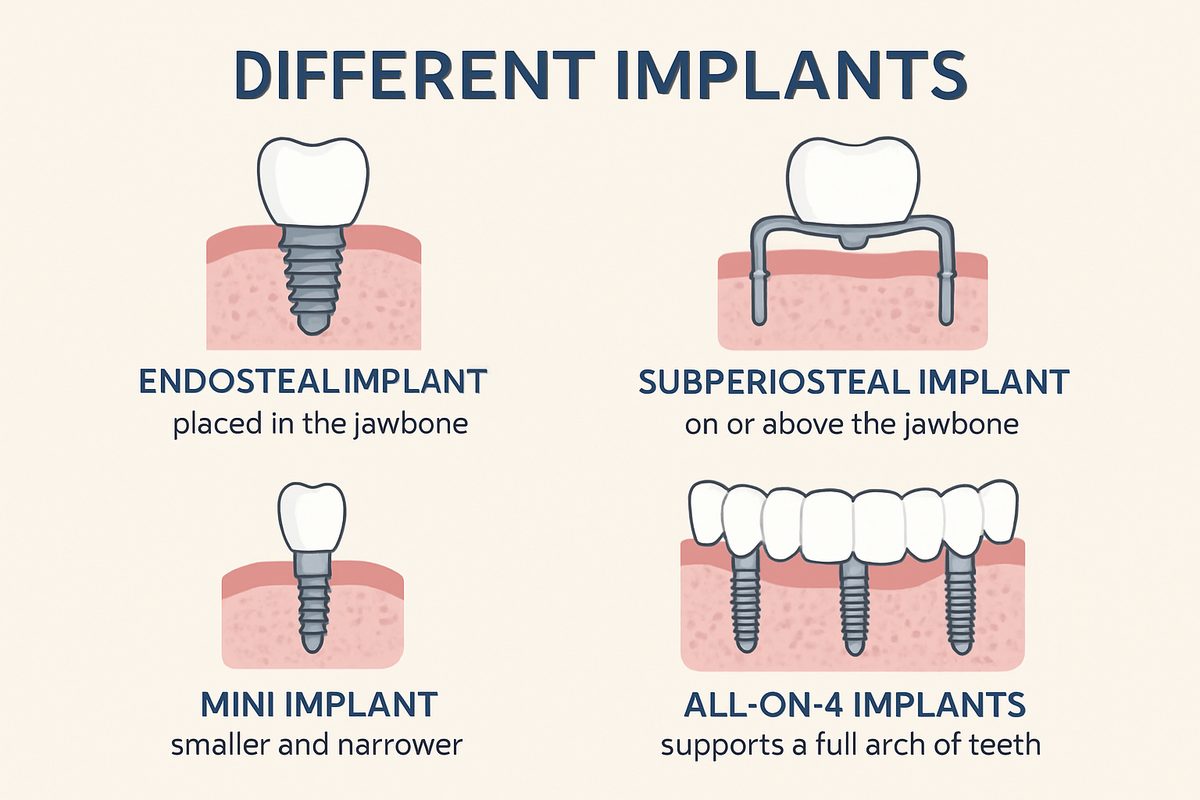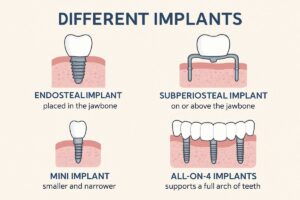You’ll learn what the different implants by Flathead Valley are, why having options matters, and how modern digital tools shape those choices. This guide explains common implant types, who fits each option, what recovery looks like, and practical next steps so you can make an informed decision about tooth replacement. We’ll use plain language and focus on what matters for real patients.
What are the different implants by Flathead Valley?
Dental implants are metal posts placed in the jaw to hold replacement teeth. There are several implant styles because people have different needs—missing one tooth, many teeth, low bone, or a desire for faster results. A dentist picks a type based on your mouth shape, bone amount, medical history, and goals. Understanding the choices helps you get a plan that fits your health and budget.
Common types of implants
Endosteal (root-form) implants
These are the most common implants. They look like screws and go directly into the jawbone. Dentists use them for single crowns, small bridges, or to support full arch work. Healing usually takes a few months for the implant to fuse with bone before the final tooth is placed.
Subperiosteal implants
These sit on top of the jawbone under the gum and are used when bone height is too low for root-form implants and the patient isn’t a candidate for grafting. They can help people who can’t or don’t want bone surgery, but they’re less common and may not last as long as modern root-form implants.
Mini implants & immediate-load options
Mini implants are thinner than standard implants. Dentists use them to stabilize dentures or when space or bone is limited. Immediate-load options let you leave the office with new teeth the same day the implant is placed. This speeds up treatment but may not be right for everyone—success depends on bone quality and careful planning.
All-on-4 / full-arch implant solutions
All-on-4 uses four implants to support a full arch of teeth. It’s a good option for patients missing many or all teeth who want a stable prosthesis without placing an implant for every tooth. Benefits include better chewing, fewer office visits, and often avoiding extensive bone grafting.
How technology changes the choice of different implants
New digital tools make implant care faster and safer. CBCT imaging shows 3D bone anatomy so dentists can avoid nerves and plan exact implant positions. Digital implant planning software maps the ideal angle and depth. In-house 3D printing creates surgical guides that translate the plan to the mouth during surgery. CAD-CAM and digital impressions produce abutments and crowns with precise fit. Together, these tools increase accuracy, reduce chair time, and often speed recovery.
Who is a good candidate for each option
Choice depends on several factors. Common considerations include:
- Bone volume and density — enough bone supports standard implants; low bone may lead to mini implants, subperiosteal options, or grafting.
- Medical history — conditions like diabetes or medications can affect healing.
- Smoking — increases risk of implant failure.
- Oral health — active gum disease should be treated first.
- Budget and timeline — some options cost more or take longer.
When bone is insufficient, a dentist may recommend bone grafting or sinus lifts to build bone before placing implants.
What to expect: recovery, risks, and longevity
After implant surgery you’ll have swelling and mild pain for a few days. Healing has stages: initial soft-tissue recovery, then bone integration over weeks to months. Risks include infection, implant failure, and nerve irritation, but careful planning and hygiene lower those chances. To maximize lifespan, maintain excellent oral hygiene, avoid smoking, and attend regular checkups. With good care, implants can last decades; restorations may need replacement sooner.
About Flathead Dental Implant Arts & Dr. Dave Dodrill
Flathead Dental Implant Arts in Kalispell focuses on digital implant care and patient comfort. Dr. Dave Dodrill, DDS (cum laude) completed advanced training at Idaho State University and uses digital workflows, CBCT, and in-house 3D printing for precise results. He’s a published author and speaker, active in community outreach, and emphasizes ethical, compassionate care.
Next steps: finding the right option for you
If you’re ready to explore options, schedule a consult to review your CBCT and get a digital treatment plan. A consult can show whether you’re a candidate for different implants by Flathead Valley, discuss sedation for comfort, and outline costs and timelines. Personalized planning helps you choose the safest, most predictable path to a stable smile.




